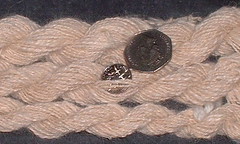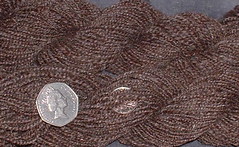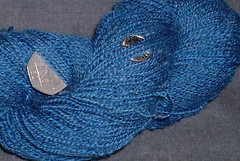Spinning to Weave
I learned to spin because I had an empty, hungry loom. My spinning has been more about weaving than anything else ever since. I do spin for knitting occasionally, and I buy lots of yarn for weaving. But I still mostly spin to weave.
Case in point: alpaca. It's very popular on the fiber front these days, and there are lots of Alpaca fiber producers, and sellers of Alpaca fiber and yarns. But there are no (to my knowledge) Alpaca yarns spun for weaving the bands and fabrics traditional to the regions where Alpaca is native: the high mountain regions of South America.
If I want a tightly spun warp yarn, I have to spin it myself:

This is some Suri Alpaca, meant for testing out a little chuspa (bag) weaving. I have two colors, and I'll dye some of each, after it's all spun up. But I had to take a break from spinning to wash the carded fibers. Ahem.
I purchased some carded batts at a fiber show. When I started to spin them, my hands (and wheel orifice) got all dirty and grungy. Huh? On closer examination, it turns out the fiber was not washed before carding. Who would do that? Only a non-spinner. Only someone who was told that the fiber is valuable, but not told how to optimize its value. Who in their right mind would think I want to pay carded Alpaca prices for dirt?
Burn me once, and all that. From now on, I will do more than look into the pretty bag, and all that tissue wrapped, carded fiber will get more scrutiny!
So, I stopped spinning and washed the batts. They came out marginally aligned, and the yarn doesn't need slip-smooth perfection, so I spun from there. I have more of the second color to spin, then a little dyeing, and I'm ready to warp.
Meanwhile, I spun up some washed carded wool:

I'm a big fan of spinning fine, and plying up for the size of yarn I want. I spin the singles fine and tight, then ply tight, 2, 3 or 4 ply, whatever I may need for the project. I use commercially spun wool rug warps as my guide; fine grist, tight twist and coarse wool. It's no wonder even my knitting yarns wear like iron:

Thank goodness the softness of the fiber saves me.
I hope you have noticed the International flavor of the scale-measuring devices. Thanks to Martine, for a 50p piece, so those UK bloggers can't fool us :-).
Case in point: alpaca. It's very popular on the fiber front these days, and there are lots of Alpaca fiber producers, and sellers of Alpaca fiber and yarns. But there are no (to my knowledge) Alpaca yarns spun for weaving the bands and fabrics traditional to the regions where Alpaca is native: the high mountain regions of South America.
If I want a tightly spun warp yarn, I have to spin it myself:

This is some Suri Alpaca, meant for testing out a little chuspa (bag) weaving. I have two colors, and I'll dye some of each, after it's all spun up. But I had to take a break from spinning to wash the carded fibers. Ahem.
I purchased some carded batts at a fiber show. When I started to spin them, my hands (and wheel orifice) got all dirty and grungy. Huh? On closer examination, it turns out the fiber was not washed before carding. Who would do that? Only a non-spinner. Only someone who was told that the fiber is valuable, but not told how to optimize its value. Who in their right mind would think I want to pay carded Alpaca prices for dirt?
Burn me once, and all that. From now on, I will do more than look into the pretty bag, and all that tissue wrapped, carded fiber will get more scrutiny!
So, I stopped spinning and washed the batts. They came out marginally aligned, and the yarn doesn't need slip-smooth perfection, so I spun from there. I have more of the second color to spin, then a little dyeing, and I'm ready to warp.
Meanwhile, I spun up some washed carded wool:

I'm a big fan of spinning fine, and plying up for the size of yarn I want. I spin the singles fine and tight, then ply tight, 2, 3 or 4 ply, whatever I may need for the project. I use commercially spun wool rug warps as my guide; fine grist, tight twist and coarse wool. It's no wonder even my knitting yarns wear like iron:

Thank goodness the softness of the fiber saves me.
I hope you have noticed the International flavor of the scale-measuring devices. Thanks to Martine, for a 50p piece, so those UK bloggers can't fool us :-).

7 Comments:
I think you are so right about fiber ranchers who don't ever have to deal with the fiber itself. I think this is particularly true of alpaca since it's the new "cash crop"--most people who raise sheep do so as an extension of their fiber work, not the other way around. I think it also might have something to do with the lack of grease in camelid fleece. Still, even I know that part of alpaca behavior is rolling in dust baths.
The yarns are gorgeous--I always get something from your posts. I really have to agree with your philosophy of spin fine and ply up to make your grist. Keep inspiring us!!
I was amazed to see the women in Peru spinning from raw locks with the dust still in them. There wasn't a lot of big VM, but plenty of pasture dust - and it just went into the yarn, pretty much.
I've been collecting international coins, too, but with a different aim - I use them for row counters.
I sometimes spin at an alpaca farm for their open house. The first year they handed me a bag of unwashed fleece to card and spin. My hands were black with the dirt and grim. I learned to ask for the fiber in advance so that I could wash it myself. It just never occurred to them.
Thank you for saying who supplied the 50p coin, otherwise I would have been accusing entirely the wrong person!
Maybe I'll see your 50 and raise you a Euro?
Carol
It kinda seems unfair, doesn't it? You'd think that purchased batts would imply that the fiber was washed. I spun llama from the lock when I demonstrated at the Nevada County Fair last year - I like to do something like that to help on-lookers get a connection that we're working from animal to yarn. I was absolutely filthy - my hands and my clothes. That was pretty uncomfortable, being out of town and still having to drive home. I love the yarn I got. But back to your "thread" -heh heh - I don't have any idea how I would use this yarn, woven or knitted. If you offer a class on this topic, I'll enroll.
I always love to get your "weaver's perspective" on things, although we are in agreement about the no dirt issue. I learned to spin in the grease, but would be resentful too, to think I had bypassed that step, only to have to do all the washing! Lovely yarns, though.
I agree with both of your points.
1) Clean fiber is a good thing!
2) Fine plies make good yarn!
Post a Comment
<< Home